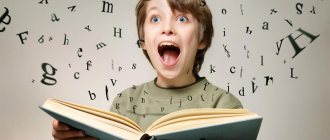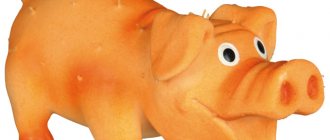The letter “Ш” is considered one of the most difficult to pronounce. To achieve clear speech in children, speech therapy classes are conducted - first on production and then on automation of hissing sounds. Working out is the final, but very important stage. It is needed for the formation of conditioned reflex connections in the cerebral cortex. When the process is completed, the child begins to speak correctly unconsciously, without any control or energy expenditure.
What you need to know about sound automation?
The peculiarities of speech development are such that the child first begins to pronounce an isolated sound. Correct pronunciation of words and sentences is more difficult for children and requires some effort. For example, you can often encounter a situation where a baby hisses “Shhh” clearly and clearly, but instead of “hat” he continues to say “sapka”. Or, in a calm state, he pronounces words correctly, but when he is emotionally excited, he begins to “swallow” or replace sounds. This means that conditioned reflex connections in the cerebral cortex are not fully formed. To complete the process and bring correct pronunciation to automaticity, training is needed.
Automation of hissing sounds is carried out in stages in a certain sequence. First, the [w] is staged, the details of which can be found here. After the child pronounces a separate sound correctly, it is practiced:
- in syllables;
- in words;
- in sentences;
- in verse;
- in stories;
- in independent speech.
It is important to follow this sequence. You cannot move to the next difficulty level if the sound on the previous one has not yet been mastered. The child will make mistakes, and this can lead to the formation of incorrect conditioned reflex connections.
Rules for successful automation
When automating sound, the correct placement of the speech apparatus plays an important role. Sometimes children forget after classes with a speech therapist how the tongue and lips work when pronouncing a problem sound. Before each lesson, you need to pronounce the correct position. The work should be carried out before exercises with syllables.
Where to start
A child and an adult must understand where the tongue is, how the teeth and lips are located. This is not easy to understand when there is no professional assistant nearby. When pronouncing the sound Ш, the lips move forward, the teeth should be partially closed. The tongue is extended forward, the tip rises to the sky without touching it. The sides of the organ should be in contact with the molars. The vocal cords are not involved in pronunciation, there is no voice.
When automating at home, you need to talk to your child about correct articulation before completing tasks:
- stretch your lips forward, imagine that it is a pipe or tube;
- stretch your tongue forward towards your teeth, lift the tip up, feel the palate;
- lower your tongue a little so that it does not touch the palate, form a gap between them;
- imagine that the tongue is a cup from which the cat will lap milk, you need to prevent it from spilling, make it deep (you need to show that the edges of the organ should touch the molars);
- try to make a sound without using your voice, as if a snake is hissing.
Parents begin work on sound automation, making sure that the child has correct articulation and can repeat it several times without gross violations.
Articulation warm-up
For successful automation, each lesson should begin with an articulatory warm-up. It allows you to warm up the muscles of the speech apparatus. It is necessary for children and adults to carry it out. To prepare the articulatory apparatus, classical exercises are used aimed at honing the pronunciation of the sound Ш: shovel, painter, pie.
Shovel
The exercise helps overcome muscle tone by relaxing the organs of articulation. You need to stick your tongue forward, it may be tense at first. Afterwards, children are asked to smile, but without straining their lips. The end of the tongue rests on the lower lip, the sides easily touching the corners of the mouth. You need to achieve relaxation of the organ; you should hold in this position for several seconds. In subsequent times, you can increase the relaxation time to train the muscles. Exercise “Shovel” is a basic exercise for correcting hissing sounds.
Painter
Children are asked to imagine themselves as a painter who needs to paint the roof of their mouth. To do this, you should open your mouth slightly in a slight smile, without straining your lips. The jaw should not move. The exercise is complex and involves “painting” the upper part of the mouth with the tongue from the pharynx to the teeth and back. Important: the child must keep his tongue in constant tension, control it so that it does not come out. The task allows the baby to understand how and where to point the tongue when making the sound Ш.
Pie
The exercise is often used in speech therapy, is complex, and trains the lateral muscles of the tongue. Don't be upset if your child doesn't complete the task the first time. Not every adult will be able to repeat the movements of a speech therapist. In children with regular practice, success comes on the 5-7th day.
You need to relax your tongue, as in the “Shovel” exercise, so that it lies calmly on your lower lip. Then ask the baby, without straining the organ, to try to bend its side parts inward, forming a funnel. As a result, the baby should see a funny “pie” made of tongue in the mirror. You need to hold this position for 5-10 seconds.
It is necessary to train not only the organs of the articulatory apparatus before automation, but also correct breathing.
Speech therapists recommend using soap bubbles, tubes, whistles, paper snowflakes or cotton balls that need to be blown away to develop breathing in children. You can play with your preschooler on his birthday, blow out the candles on the cake or pie that mom prepared for the doll. An adult can inflate balloons.
Recommendations
Consolidating the correct pronunciation of sounds in speech is called automation. The process should not be taken lightly. It is important to move to this stage only after regular articulation gymnastics, when the baby begins to make progress in correct articulation and positioning. Automation of the sound Ш occurs in words, sentences, and text. You always need to start with the easy ones and gradually move on to the complex ones: from syllable to word, from sentence to text.
Automation of the sound Ш in words implies compliance with the rules:
- It is impossible, if there are problems with several consonant letters, to automate all at once those that a person confuses in speech: Ш, С, Ш, Ж, З, etc.;
- you need to move on to fixing the sound after a person learns to pronounce it autonomously several times in a row;
- in the process of automation, the child needs to use visual material to make it interesting to learn (cards, coloring books, cubes, etc.);
- Before doing exercises and reading, always warm up the articulatory muscles with the help of gymnastics;
- when automating, adhere to the rule - act from simple to complex;
- You need to practice every day, without burdening the child or adult (preschooler - 15 minutes, schoolchild - 20-25 minutes, adult - 30-40).
Automation of sound is a complex but interesting process. The result and the duration of the correction will depend on the reason for the incorrect pronunciation. You need to approach each individual case individually. If parents cannot correct their pronunciation over a long period of time, they need the help of a speech therapist. Perhaps the cause of the problem is the peculiarity of the structure of the speech apparatus, then, along with speech therapy classes, the help of doctors will be needed.
Basic methods for producing the sound “Ш”
Speech therapy classes on the letter “SH” begin with developing the pronunciation of an isolated sound. One of the most effective ways is to stage the sound from other sounds.
If the child pronounces the sound “T” well, then this is one of the easiest ways. To do this, the child must pronounce “Shhhhhh” until you achieve normal pronunciation. After this, ask him to do the same procedure, but “hiding” his tongue behind his teeth. The result is the sound “SH”.
If in doubt, you can do this yourself. The “hissing snake” exercise is suitable for consolidation. For variety, associate this sound with the sound of a deflated ball or the hiss of a cat.
Why doesn't the letter "Ш" hiss?
The reasons for incorrect pronunciation may be the following:
- Physiological: malocclusion, large tongue, high palate. In addition, the quality of the spoken sound depends on the development of the speech apparatus.
- Prolonged use of the pacifier. This item spoils the bite, which leads to distorted pronunciation of whistling and hissing sounds.
- "Lisping" with a child. By repeating after their elders, children distort their speech.
- Repeating incorrect pronunciation after adults who have speech impediments.
- Memory, thinking and attention are poorly developed.
- Speech hearing impairment (in some cases, dyslexia may develop).
If, after homework, the child still cannot pronounce the letter “SH,” you should contact a speech therapist.
Video about making the sound “Sh” for a child
How to play the sound Sh for a child in 1 minute:
Speech therapy games
Speech therapy games for the sound “sh”, like any entertaining activities when practicing difficult sounds, are liked by the baby. They help not only to have fun, but also to develop in preschoolers correct sound pronunciation and the ability to correctly use a given sound in speech. Also, speech therapy games interest children in further work, which helps to significantly accelerate learning progress.
Sound Automation
Automation of “sh” occurs when working with syllables, words and sentences. For a more enjoyable pastime, you can buy special coloring books, pictures, cards or a drawing album, where you can draw illustrations with your child. The baby will draw and speak at the same time, thereby strengthening the skills.
The following activities are held in the form of a game:
- First, individual syllables are pronounced: sho-sha-shu-she-shi,
- Then the words are added: checker, highway, cones,
- And then you can move on to sentences, tongue twisters: Sasha walked along the highway and sucked on a dryer.
How to teach a child to say the hissing sounds “sh” and “zh” correctly
Sound reinforcement games
Speech therapists have a special tactic in their approach to classes: the child is offered those tasks that he likes. Children who play are much easier to teach than those who are bored.
We offer a number of games to automate the sound “sh”:
- “Snake”: the picture shows a snake that wants to get into the house. It is on the other side of the maze. The baby’s task is to help the snake crawl home by moving his finger through the maze and pronouncing the sound “sh”.
- “Help the mouse”: the plot of the game is a mouse running away from a cat. The child needs to read syllables sequentially, and then words with the letter w, so that the rodent can escape from the cat. The first time, focus on correct pronunciation, and then you can suggest increasing the speed of the mouse, reading syllables and words faster.
- “Speech therapy fairy tales with pictures”: come up with or take a ready-made fairy tale from the Internet, where there are many words with the sound “sh”. The child’s task is to read the fairy tale, pronouncing the sounds correctly.
Tongue twisters guarding diction
We suggest you remember and recite the following pure sayings for preschoolers. There are a lot of them, you can choose any to remember.
Here are a few tongue twisters for the sound J.
And this way you can train the sound Ш.
Tongue twisters with the sound |tʃ|
- Cherry tea ch es ch ildren at ch ur ch . Ch erry also checks the rooms and does ch ores.
- The tea ch er changed the ques t ion in the ch Allenge. The ch Allengers changed the answers for the ques t ion.
- Charles is a ch eerful ch icken farmer. A poa ch er is wat ch ing Ch arles' ch ickens ch oosing whi ch to snat ch , and ch uckles at the ch ance of a ch oice ch icken to ch ew for his lun ch . But the ch uckle rea ch es Ch arles who ch ases the poa ch er and cat ch es him.
As a song example, the classic “We Are The Champions” by Queen.
From 0:38 to 1:17






